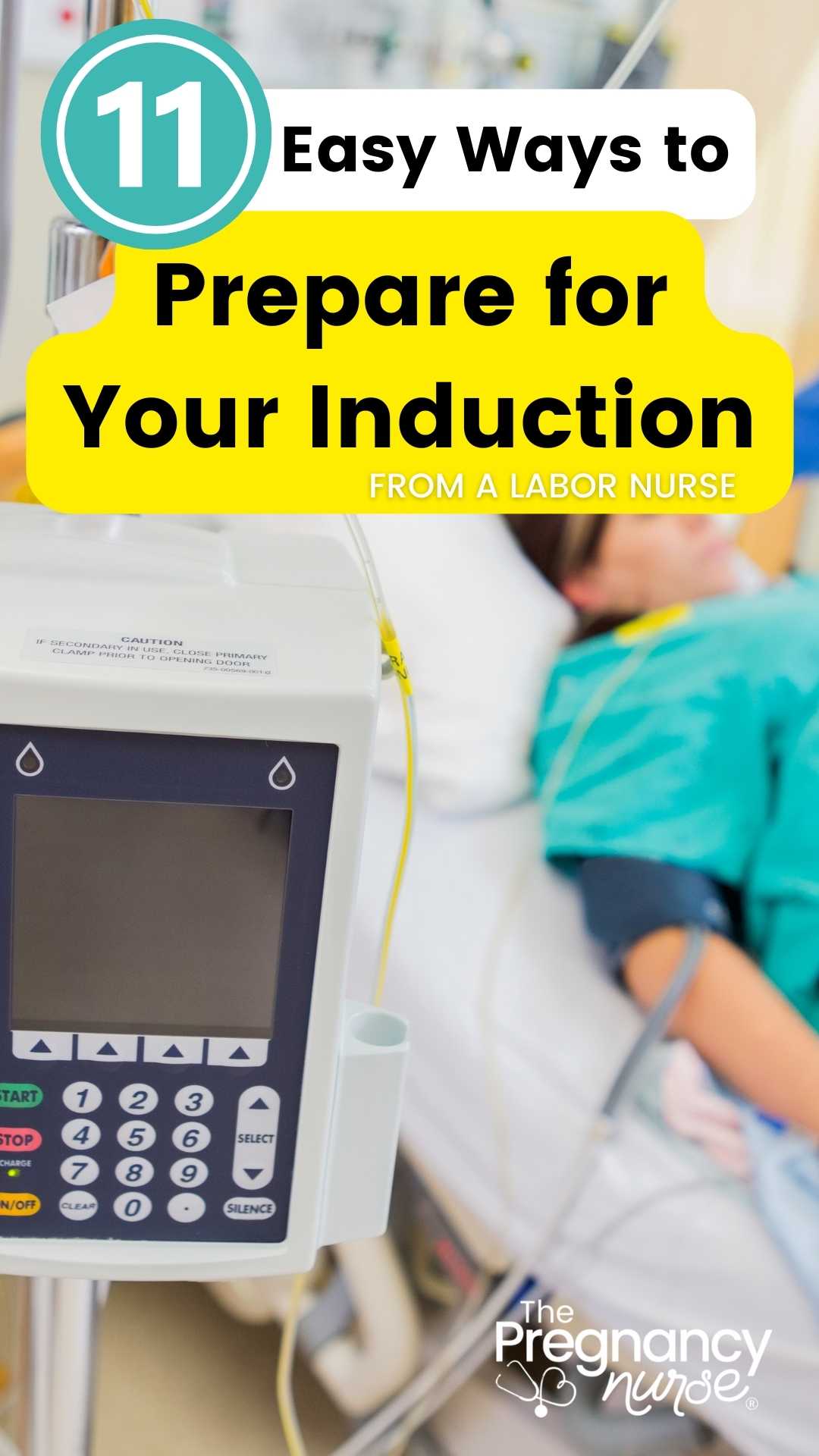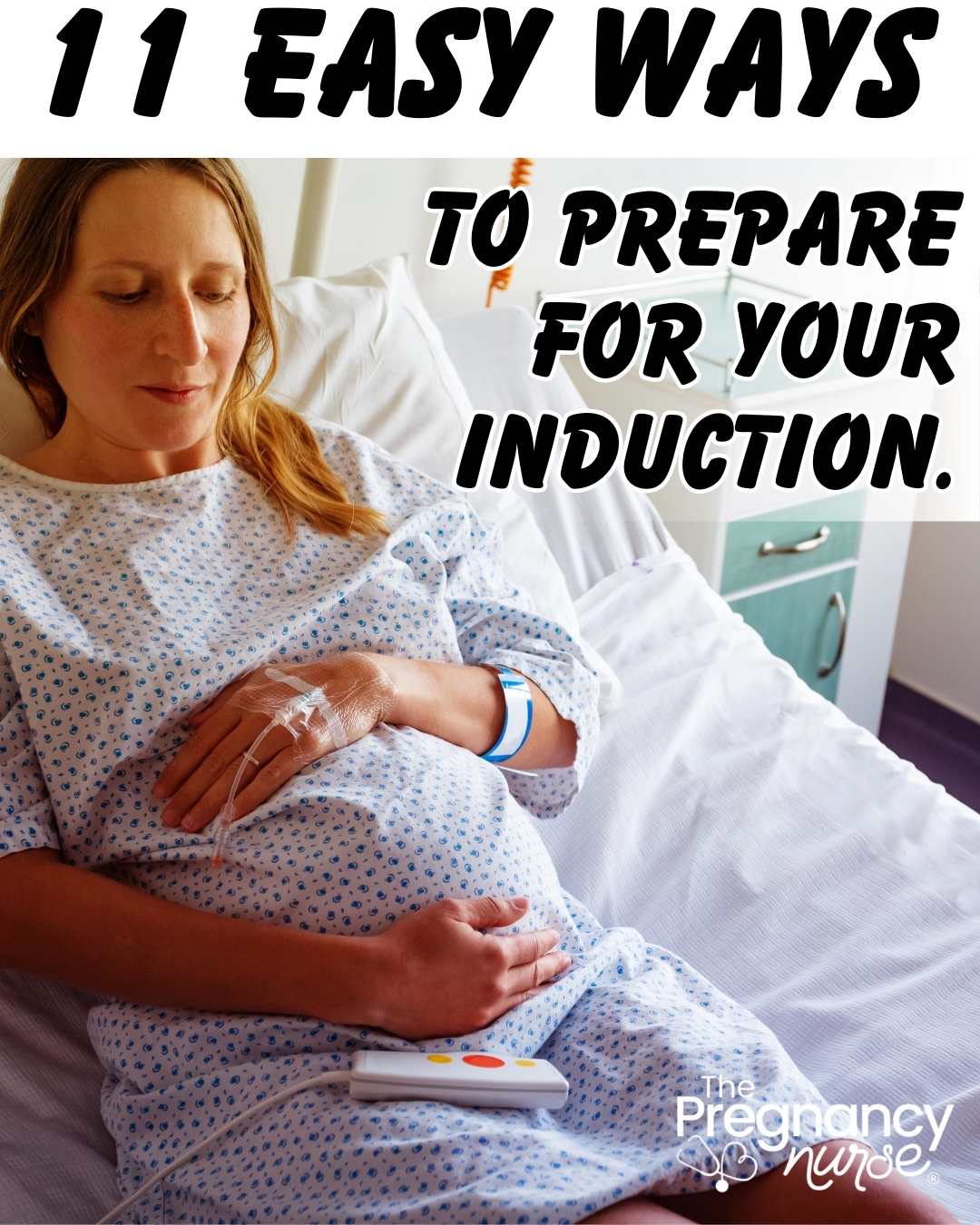Preparing for your induction can be intimidating. Suddenly, something that was unknown seems VERY known and it’s happening soon (it may be tomorrow, or you have an induction date saved for you). Today I’m going to give you my best tips as both a labor and delivery nurse and also a former induct-ee to how to best prepare for your labor induction!

But first, how do I know so much about inductions?
Hi — I’m Hilary — The Pregnancy Nurse 👩⚕️. I have been a nurse since 1997 and I have 20 years of OB nursing experience, I am also the curly head behind Pulling Curls and The Online Prenatal Class for Couples. 🩺 I have started (and delivered) thousands of inductions, and I have also been induced with one of my pregnancies as well. I well understand the worry and concern an induction can cause, and also how they happen. so, let’s get started.
This post will be split into three topics — talking with your providers, preparing your body & things, and preparing your brain. Within those we’ll talk about these:
just click to the area you want to learn about if you want to learn more just on that topic (although I suggest you read all 10 because they are each helpful in their own way!)
What we will cover:
- Ask Your Provider WHY You’re being Induced
- Ask Your Provider how will you be induced?
- Find out hospital induction plans
- What to Eat Before an Induction
- Sleep Before Your Induction
- Move your Body Before Your Induction
- Pack Your Induction Bag
- Pamper Yourself
- Learn About Your Induction
- Keep a Positive Mindset
- Include your Partner or Your Labor Support Person
Questions to Ask Your Providers to Prepare for Labor Induction
I put this one first, because I truly believe you don’t move on until you have at least the first question answered. Your healthcare provider (doctor or midwife) is the one writing the orders, and the one with lots of experience. Ask them lots of questions, that’s what you’re paying them for!
If you’re having testing done that you don’t quite understand, come join me in my free beginning prenatal class where we simplify those tests and what they can tell you about you/your baby.
Ask Your Provider WHY You’re being Induced
You’ll want to know WHY you’re being induced. I’m always surprised by how many people come in and have no idea why their doctor as recommended an induction.
Remember that there are LOTS of reasons why providers may think that your baby is safer to be induced rather than staying in the womb including:
- High blood pressure or signs of preeclampsia
- Diabetes or Gestational diabetes
- Low amniotic fluid or excess amniotic fluid
- Baby measuring small or not growing well
- Past your due date, or close to 42 weeks of pregnancy
- Other pregnancy complications that may arise
If you are being induced before 39 weeks pregnant your doctor does have to provide a REASON for the induction in order for us to bill your insurance. So, there has to be a reason — so just ask.
BTW, if talking with your provider is hard I have a bonus video in here where I go over real-life scenarios and how you could handle it — sometimes giving you words to say is a nice first step.
They should also go over the benefits and risks of your induction before you making your choice. This is called an informed consent — and your doctor should do it before they try and induce you. There are risks with an induction (like the possibility of uterine rupture or needing a cesarean delivery) as there are with any medical procedure, so they should review them with you.
It isn’t unusual for your provider to recommend you have labor induced. Many women are induced, so don’t feel like a failure if they recommend an induction. In many cases you also have a lot of wiggle room as to if you need to be induced right away or could wait if you’d prefer that — so talk with your provider!
You also may be asking to be induced — which is totally fine too.
If you want to have an elective induction (an induction for no medical reason), you need to be at least 39 weeks of pregnancy on the day that you are induced. Some hospitals may not allow you to be electively induced until you are 40 weeks pregnant (depending on their policies).
But, either way, know the reason. It may be important to know on your next baby also!
Pro Tip: If you’re feeling “pressured” into an induction this is the time to ask ALL the questions. You can refuse anything you want during your pregnancy, but it is much easier to talk with your provider now about it. They will most likely not be at the hospital when you get admitted so you want to be very sure this is your best choice now. If you’ve already passed your appointment, call your doctor and speak to them again about your choices. An induction is YOUR choice, not their’s, and you want to be very clear on that in your mind.
I actually just did a podcast on being informed about your induction that you might enjoy:
Ask Your Provider how will you be induced?
This is a big one. Most often, before an induction, your provider is going to check your cervix. The method they will chosen depends on how ripe your cervix is and how ready it is to start dilating.
The results of your cervical exam are combined into what we call the bishop score (which takes into account your dilation, how thin and soft the cervix is as well as where the baby’s head is in the pelvis).
At that point they will pick between these as their initial induction methods:
- A Foley balloon catheter (the foley bulb can be combined with other methods)
- Prostaglandins to ripen your cervix more
- or Pitocin
Pro Tip: Some people call a membrane sweep (also called stripping your membranes) an “induction” method but it’s not really proven to work. However, if you’d like to go into labor soon it is something they can try and has had some success. If you need to be induced, a membrane sweep won’t be enough. You can always ask them to try it before an induction, to see if it helps…
They also have in their mind about how long your induction may take. That isn’t to say we’re always right. Sometimes an induction is much quicker than they anticipated, and sometimes it is longer, but they have a guess in their mind.
So, ask your provider how they plan to induce you (knowing what to expect will help you feel better) and a guess on how long it is going to take.
Pro tip: Providers hesitate to make “guesses” so be very clear you understand it’s not a guarantee but just an educated guess and you’ll have to see how the induction process is going to go.
If your provider says it could be a long day, make sure you pack a few extra things in your bag. We’re going to talk more about that below.
Another thing to ask them is when you will see them next at the hospital.
Some providers come in to rupture membranes on every pregnant patient who is being induced. If that isn’t something you want, it’s a good time to say you’d prefer to wait to have your amniotic sac ruptured (or hope that it will rupture on their own). The idea is that once your water breaks labor speeds up (although that isn’t proven to be the case if you’re still in early labor ).
Also, your provider might not be on, and you will be seeing a different ones, and that is always nice to know.
Reminder: All inductions of labor will need to have an IV in. This is due to the increased risks, and possibly needing to use that IV to do the induction (Pitocin is given via IV). If you were planning to labor without an IV this is something to be aware of. Sometimes they can leave it as just a saline lock, and sometimes they need to have it plugged into the IV pump (depending on how you’re being induced).
Prostaglandins vs Pitocin
I wanted to quickly chat about the difference between prostaglandins vs Pitocin — they’re very different induction techniques, and I think it helps to understand them.
Prostaglandins are hormones that are given either vaginally or orally. They are Cytotec (Misoprostil), Cervadil and Prostin Gel.
In general, they are given when your cervical exam shows less than 3 cm dilated. Many hospital policies states not to give them after 3 cm. There are some cases in which they can’t be given (like VBAC and previous uterine surgery) but in general are a great option if your cervix hasn’t reached that 3 cm mark (and isn’t QUITE ready for Pitocin).
Scientific evidence show that inductions using prostaglandins appropriately experience shorter labor times vs Pitocin alone. Prostaglandins tend to make your uterus create smaller contractions that ripen the cervix (vs “banging” it open with Pitocin).
Cervical Metaphor: I like to compare your cervix to an Avocado. If it isn’t soft you don’t want to eat it, but if you’re able to RIPEN it, it’s much easier to make into guacamole.
Cervical ripening has been a big win in my time as a nurse, and I’m glad it’s an option most doctors are using now (not true as to when I started). This is most often the route a first-time mom is given to get induced (but also plenty of second+ time moms).
Pitocin is the synthetic version of the hormone Oxytocin. It is given when your vaginal exam says you’re past 3 cm or prostaglandins are contraindicated. Or, if your cervix is super soft and we feel like you’re ready to not waste the 4+ hours a prostaglandin would take, and move directly to Pitocin — often that would be for patients who have previously had a vaginal delivery. It is given IV and tends to produce stronger contractions than prostaglandins. Often these are more painful contractions (but not always).
These aren’t so much chosen due to your issue being induced (although if baby isn’t tolerating one medication we may try another). However, most often if you’re closer to your due date, your cervix may be more open and we’d skip straight to Pitocin — but that’s not always the case.
I have a whole post about Pitocin vs Cytotec you might want to check out if you have more questions.
Pro Tip: Ask your doctor how much movement you’ll be able to have during your induction. I find movement to be a key. But, with an induction they may need to monitor baby’s heart rate continuously. Many hospitals allow some periods when you’re off the monitor with other methods of labor inductions, so ask your provider what to expect as far as that. We talk about movement a lot in here.
Reminder: You can still move a LOT while even hooked into a corded monitor, but wireless monitors are available more and more. The main issue is being able to monitor your baby in the position of your choice. Sometimes it gets really hard depending on how baby is facing and the monitor I’m using. Keeping an eye on baby is very important in an induction so sometimes it does limit things.
If your cervix is already VERY ready (thinking past 5 cm) they may just have you come in and try breaking your water. Often at that advanced stage that’s your best labor induction method. Or, sometimes you also require pitocin.
Labor Fact: Once you have your water broken there’s no chance of going home with a “failed induction” — you will need to deliver your baby soon as there is an increased chance of infection once your water is broken. Most often that doesn’t happen, but I think it’s good to know that sometimes patients do get sent home (sometimes called a “failed induction”) if your body just not ready for labor, and the reason for the induction could wait a few days.
Find out hospital induction plans
So, every hospital schedules inductions differently.
You may get a date and a time — but you need to be aware that this “time” is varying depending on the staffing and what’s going on at the hospital at that time. I never think it’s a bad plan to call 4’ish hours before (or the night before when you go to bed) to see what the labor unit is thinking and if there’s a chance you be “bumped” due to hospital issues.
Some hospitals just put you on a waiting list and call you when a room is available for you.
So, understand how your hospital does it. Don’t be afraid to call the hospital beforehand, and if they bump you don’t be afraid to call every 6 hours or so for an update on their plans to alleviant any anxiety you’re feeling about “when” it will happen. I promise that your induction is on that charge nurse’s mind. You may be the “next in line” or you may be many spots “down the line” to have your induction and it will help you know what to expect if they give you this information.
The hospital understands it’s stressful to wait at home. But, their number one job is to make sure everyone on the unit is safe. It would be really irresponsible for them to bring you in for an induction if they can’t be sure to keep you safe during this time.
Pro Tip: An elective labor induction (being induced without any medical reasons) is often bumped before inductions for a medical reason. The staff just needs to prioritize those who need to be induced over those who want to be induced for the safety of their babies.
I also have some good tips in my video on preparing for an induction:
Prepare Your Body
It’s easy to just put your body and into the hands of your providers for your induction, but it’s important that you do your part so you can have the best induction possible!
Pro Tip: This doesn’t mean you try to induce labor on your own at home. Honestly, the safest methods of inductions are those that happen in the hospital. If you try midwives brew with castor oil tonight to get labor going you’re not going to be happy tomorrow (but you will be in the restroom a lot).
What to Eat Before an Induction
Most often your provider will be fine with you eating before an induction. You can always double check with them (sometimes they are weird if you are attempting a TOLAC/VBAC induction), but most often they encourage you to eat before your induction.
The night before I’d have a GREAT “send-off” meal. Get something that’s a favorite of yours (bonus if you don’t have to make it, but if you love cooking go for it!). Enjoy this time for yourself, and with your partner.
Meals are going to look different after baby is here, so really remember this one. Don’t worry you will eat again without being rushed or holding a baby, but it may be a few weeks — so enjoy it!
I would recommend a meal that isn’t super greasy, and “eats the rainbow” if that makes sense. You want lots of good carbs, proteins and minerals to give your body it’s best chance. This will really help prepare for your induction by giving it lots of good things to actually create labor out of.
The meal before heading into your induction (be sure to read my hospital plan section above to learn more about this, because this time can change) I recommend something that balances carbs and proteins and is not heavy. You don’t want to walk into the labor room on a very full stomach. Not only will you be uncomfortable sitting there, but it may make you extra worried about pooping while giving birth, and sometimes once you start contracting your stomach wants to get in on that action too and may make you nauseated.
Not sure how to balance carbs and proteins? I have a great bonus video in the Bump to Bassinet Bundle that explains it and gives some great options.
So, a nice light meal is great. If you’re craving a breakfast burrito, go ahead and grab it, but maybe split it with your partner.
Pro Tip: Some people are able to eat during their induction in the hospital (especially in the beginning) so talk with your provider about what the eating during labor (at least initially). I always recommend you bring some snacks, but we’ll talk more about that in the hospital bag section.
Sleep Before Your Induction
So often patients don’t sleep well before their induction of labor. Dreams of Pitocin and Cytotec run through their minds. They wonder what it will be like… and may have some nightmares about that as well. A few thoughts on this….
You need your sleep — don’t be silly and think it’s fine if you stay up all night because you’ll rest in the hospital. It is going to be a long day with many choices and decisions and sleeping well will be a solid foundation.
If you’re concerned about sleeping (aka, you’re worried, have had issues sleeping in the past) maybe ask your doctor if you can take anything. They may recommend a Benadryl (and that may be enough for a lot of you).
If you feel like you need something more to sleep the night before, don’t be afraid to ask for it. I often asked for it for patients in the hospital and they’re fine to give something for one night’s rest at the end of your pregnancy. Just make sure to take it early (and don’t go to bed super late) so you’re not super groggy in the morning. Also, ask for something very low dose if you haven’t taken anything before (or just try benedryl — it works for most people).
If you’re worried, get prepared! Often it’s the fear of the unknown keeping you from sleeping. If your induction is in the morning grab my Inductions Made Easy quick class, but If you have a bit more time (the full class only takes about 3 hours) I recommend The Online Prenatal Class for Couples. Not only do we have a full chapter on inductions, but tons of information on pain management, epidurals, what it will look like when you go into the hospital — just so everything is familiar and not scary. You’re gonna thank yourself for investing in that!
Pro Tip: Please don’t just tell yourself “I’m fine” when you know you’re just ignoring the fact that you’re worried. Take the class!
Your induction, if it’s a long one, may extend through a night. You can always ask for a sleep aid in the hospital as well. I love to give my long induction patients a tiny sleeping pill and get them as comfy as I can. Sleep is a big win in the labor world to prepare your body for labor!
Move your Body Before Your Induction
I think this is one a lot of people miss. You should still be trying to do the things to help that baby find their right spot before your induction.
Now, if you’re having an early induction your cervix may not be all that ready — but you can give it a try. Also, the stretching (maybe some prenatal yoga!) will feel good no matter what you’re doing.
Often when we get worried about something we tend to tense our muscles and stay in one position for a long time. Keep moving your body! Not only will it help you to not get “stuck” in your worry, but it will also help you to just feel better overall.
No idea what to try — the Miles Circuit is a popular one (but I always recommend trying it and then doing the ones that feel best to you).
Pack Your Induction Bag
An induction bag looks a bit different than if you’re going into spontaneous labor. The biggest one is that you may have a bit more time to really think about what you’re packing (vs someone who’s throwing things in a bag while in pain).
Grab my hospital bag checklist while you’re here — it’s a good start for everyone:
The main difference for an induction bag is that you may have a good amount of time to wait during the induction process. I would recommend including:
- Snacks that balance proteins and carbs for both labor partners (this makes it your choice if you eat or not in labor, because if your doctor doesn’t order food the nurse can’t give you any)
- A few things to do — favorites of mine include:
- Playing Cards (seriously, couples love playing these on their tray tables, makes the time pass for both of them)
- Downloaded movies on a screen you can watch together (hospital movie offerings can be a gamble)
- A journal to write your thoughts and feelings in
- I would also recommend a robe or something to cover your backside as you’re there longer. I always recommend one of these, but people find them more helpful as they may walk the halls with a misoprostol induction.
Bonus: I saw a doula who recommended bringing your breast pump in your bag. It causes nipple stimulation and may make those prostaglandins or Pitocin more effective at creating good uterine contractions. Your providers may or may not not be OK with it (but you’ll probably want it after baby anyway) — but it could be worth a try.
Pro tip: Remember when you’re in early labor at home you have lots of time to do household stuff while you’re in labor. In the hospital when your labor is induced you’re stuck there (and likely need to be monitored) so you’ll need to keep your body moving in a space that isn’t as comfortable for you.
Pamper Yourself
I think it’s a great time to do something you love. Some ideas:
- Schedule a massage (this would be amazing, but not always possible) — who knows, maybe it will put you into labor.
- Get a pedicure or a manicure
- Take a warm bath (if you like these this far into your pregnancy)
- Have a nice shower, and then have your partner rub your legs and feet with some good-smelling lotion
- Watch a show you love before bed
Pro Tip: Just because you loved a lotion smell before you were pregnant doesn’t mean you’ll love it now so make sure you pick a scent you love now.
Prepare your Mind for your Induction
I’ve saved the most important part for last in this post. Your brain may need some extra support right now, so let’s give it to it!
Learn About Your Induction
Understand what is going to happen in an induction is really going to help your mind wrap it’s mind around the process.
This labor may be more medical than you had hoped (or perhaps this is how you wanted it). It may be painful in a different way than you had wanted.
You worry about the “cascade of interventions” and how you can disrupt it (thank you social media).
So I recommend taking a prenatal class, or at the very least taking Inductions Made Easy.
One thing that might interest you is that during the Arrive Trial (where they compared an induction at 39 weeks vs “expectant management” – or waiting to see if the patient needed to be induced or would go into labor on their own) the people actually scored their pain the same during an induction vs spontaneous natural labour.
Personally, I think labor contractions feel the same both ways — it is just much more boring in the hospital (I have had both spontaneous labor and induced labor).
Wondering more about this Arrive trial? I have a bonus video in here on it.
That being said, because an induction happens all in the hospital I do find that the majority of people end up wanting an epidural for pain relief (and be able to get some sleep). So, it’s important to have an idea of what that is and how it can help.
Also, a prenatal class can really prepare you for the timing to come. Many people end up craving a c-section because they simply weren’t prepared for how long the induction would be — and don’t make efforts to be as comfortable as they can during the process.
Keep a Positive Mindset
I cried and cried and cried after I finally accepted that I needed an induction (I was 12-days overdue). It just wasn’t what I wanted for my last delivery (it was my third).
In reality I wish I’d be like “Ok, that’s what we’re doing” and gone and gotten some frozen yogurt and pampered myself because sometimes it’s hard when things don’t go according to your plan.
I made it MUCH harder than it needed to be, and it is much easier to see 14 years later.
This induction may be exactly what you wanted (because you are OH so done being pregnant). Or, it’s not the plan you wanted. And either of those is fine.
But, since you’re reading this article it sounds like an induction is pretty likely for you — so it’s time to be OK with it.
Grab my positive pregnancy affirmations right here:
Remember the Arrive trial showed that it was just as safe (if not safer) to be induced rather than waiting — and that you possibly decreased your chances of a cesarean section, no matter if your cervix was ripe or not at your induction.
So, say some positive affirmations. Say them out loud, get your partner to say them, think them when you’re getting ready. Keep it positive, and flexible!
Staying flexible is my #1 labor tip that I talk about in chapter 10 in here.
Include your Partner or Your Labor Support Person
All through this I’ve talked about the pregnant person. And you do have a LOT to think about since this is all happening to you. But, your partner also needs to be prepared. Especially if they are also going to be a parent to this baby.
While you might understand this induction is going to take a while, maybe you forgot to tell them. Maybe they’re not prepared with things to do and snacks in their bag so make sure you communicate with them.
Telling them your hopes or fears will bring you two close together and will also help them to keep you positive during the day.
And, if they are worried about it make sure to take your prenatal class with them. The Online Prenatal Class for Couples was MEANT to be taken with your partner.
I just got this review from Daniel — a PARTNER (I love partner reviews):
“This class really helped prepare my wife and I before our first child. Questions we did not even have initially were answered with the multiple sections. Also really nice to be able to go back and re-watch/re-read lessons.”
Read more prenatal class reviews here
If your induction is tomorrow and you only have a few hours you can watch Inductions Made Easy together to get on the same page.
Just don’t forget them. While this is happening to your body — and it can be VERY overwhelming for you — it’s still something big happening to them, and you’re in this together!
It will feel amazing to have their support during this time!
So, those are my best things to do to help you prepare for an induction. In reality, inductions don’t always look all that different than “natural” labor — but by being prepared for what is different you’ll thank yourself for that time well-spent!
If you’ve read all of these and you still feel very unprepared to start labor, it’s important to ask yourself why.
- If you’re scared — take a class
- If you’re not sure you’re making the right choice, make a phone call to your provider (I would also stay off social media at this point because there is a lot of unfounded negativity surrounding inductions on there)
- If you’re nervous to be a mom — that’s NORMAL. A class may help you with some newborn care tips, but it’s a big change and I know you’re going to be great at it!
Pro Tip: Getting your BRAIN on board can really help labor to start more easily. Induction doesn’t work the same for everyone and I swear often times it’s because their brain isn’t on board yet. So figure out WHY it’s not on board and fix it (and I really think this fixes most of the problems).
Anything else YOU are doing for induction? Tell me in the comments!









 Can I Get An Epidural at 7 Centimeters? Is it too late?
Can I Get An Epidural at 7 Centimeters? Is it too late?

This was such a wonderful post, thank you! Inducing tomorrow, just past 41 weeks.
I’m so glad you liked it. Congratulations on your baby!!